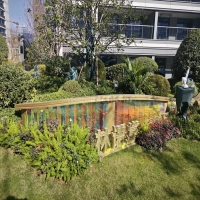Welcome to the website for landscape facilities products and knowledge.
How does the choice of seating (e.g., stools, benches) complement the design of a landscape bar counter?
The symphony of a perfectly designed landscape bar isn't just composed of fine spirits and skilled mixologists; it is conducted through the deliberate harmony between the counter itself and the seating that surrounds it. This crucial design choice moves far beyond mere functionality, deeply influencing aesthetics, social dynamics, and the overall patron experience. The selection of stools, benches, or other seating solutions becomes an integral part of the bar's narrative, shaping how guests interact with the space and each other.
A landscape bar counter, often characterized by its organic, flowing forms and integration with its natural surroundings, demands seating that complements rather than conflicts. The choice becomes a fundamental exercise in balancing form and function. For a sleek, modern countertop made of polished concrete or honed granite, minimalist backless stools with clean metallic frames and subtle wood accents can extend the contemporary aesthetic. This maintains sightlines across the space, preserving the visual impact of the bar's design. Conversely, a rustic bar crafted from reclaimed timber or natural stone calls for the grounded, communal feel of sturdy wooden benches or chunky, forged iron stools. These choices anchor the space, reinforcing a theme of authenticity and rugged charm.
The height and proportion of seating are non-negotiable elements of functionality and comfort. Bar stools must be meticulously scaled to the counter's height to create an ergonomic relationship between the guest and the bartender. The standard 30-inch counter pairs with 24-inch stool seats, but variations exist. This precise calibration ensures comfortable arm placement for drinking and conversing, preventing the awkward slouch or reach that can break immersion. Beyond individual comfort, seating arrangement dictates social flow. A linear arrangement of stools fosters a more intimate, focused interaction along the bar's length, ideal for solo guests or pairs. Introducing curved benches or clustered seating groups around wider sections of the counter encourages conversation and community, transforming the bar from a service point into a social hub.
Material selection for seating is a critical dialogue with the outdoor environment. In a landscape setting, durability against sun, rain, and temperature fluctuations is paramount. Teak, powder-coated aluminum, all-weather wicker, and marine-grade polymer rattan offer longevity without sacrificing style. These materials ensure the furniture withstands the elements while maintaining its visual appeal season after season. Furthermore, textural contrast plays a vital artistic role. The smooth, cool touch of a stone or poured concrete counter is wonderfully offset by the warm, tactile grain of wood or the soft weave of textural cushions. This layering of materials adds depth and sophistication to the design, inviting touch and enhancing the sensory experience.
Ultimately, the seating is the primary interface through which a guest experiences the landscape bar. It is the physical connection point that can either elevate or diminish the entire concept. A well-chosen stool or bench supports the body comfortably, allows for easy engagement with the bar and other patrons, and visually completes the architectural statement of the counter itself. It transforms the act of having a drink into an immersive event, framing the view, facilitating connection, and making the human form a part of the landscape's composition. In the art of bar design, the seats are not an afterthought; they are the final, essential brushstroke that brings the entire picture to life.
Related search:

Recommendation
Metal and acrylic color-changing combined curtain wall for large-scale public landscape facilities